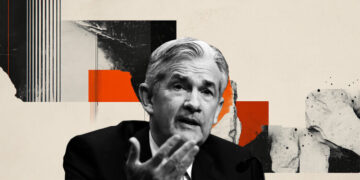- USD/INR slides to two-week low amid broad US Dollar weakness and strong Rupee demand.
- Rupee supported by FII inflows, equity market gains, and falling Crude Oil prices.
- DXY holds near a three-year low as Trump’s Fed criticism and soft US GDP fuel rate cut bets.
The Indian Rupee (INR) strengthens further on Friday, riding a wave of US Dollar (USD) weakness, as the Greenback slides further amid political noise and soft economic prints. US President Donald Trump’s fresh criticism of Federal Reserve (Fed) Chair Jerome Powell, paired with weaker-than-expected US Q1 Gross Domestic Product (GDP) data released on Thursday, is weighing heavily on the Greenback. As a result, the US Dollar Index (DXY) remains pinned near a three-year low, boosting demand for emerging market currencies such as the Rupee.
USD/INR remains under pressure, trading near a two-week low around 85.50 during the American trading session. The US Dollar Index (DXY) is holding near 97.14 after May’s Core Personal Consumption Expenditures (PCE) Price Index came in stronger than expected. Despite the firm reading, broader concerns around US fiscal policy and political pressure on the Fed continue to cap upside, keeping the DXY pinned near three-year lows.
President Trump’s pointed criticism of Fed Chair Powell has sparked renewed doubts about the central bank’s independence, prompting traders to increase interest rate cut bets. There’s growing chatter that Trump could try to influence policy through a “shadow chair”—an unofficial figure position to influence the Fed’s policy direction until Jerome Powell’s term ends in May 2026.
Markets were quick to react, with traders on Thursday boosting bets on interest rate cuts. According to CME Group data, the probability of three cuts this year has climbed to around 60%, up from just two cuts expected earlier in the week.
- The Indian Rupee is staging a solid recovery following the ceasefire between Iran and Israel. On Friday, the Rupee appreciated by 23 paise to 85.49 against the US Dollar, supported by strong foreign institutional investor (FII) inflows and a risk-on tone in domestic equity markets.
- On the Equity front, Indian equity benchmarks ended higher for the fourth consecutive session on Friday, with the Nifty50 closing at 25,637—its highest level since September 2024—led by broad-based buying except in IT and realty sectors. The Sensex gained 303 points to end at 84,058.
- Lower Crude Oil prices are also aiding the Rupee’s recovery by lowering import costs and easing the trade deficit, especially after the Iran-Israel ceasefire eased geopolitical tensions. Both WTI and Brent Crude have dropped around 12% this week, with WTI trading near $65.20 and Brent around $67.05 at the time of writing.
- Trade negotiations between India and the US have reportedly stalled over disagreements on import duties for auto parts, steel, and agricultural products, said Indian officials with direct knowledge. This setback dims hopes of reaching a deal before President Trump’s July 9 deadline to impose reciprocal tariffs. While US officials have repeatedly stated they are close to finalizing a trade agreement with India, no official announcement has been made so far, keeping markets in wait-and-watch mode.
- US President Donald Trump may extend the looming deadlines for reimposing higher tariffs on imports from several countries, the White House said on Thursday. The tariffs, initially scheduled to take effect on July 8 and 9, are no longer viewed as fixed. White House Press Secretary Karoline Leavitt told reporters the dates are “not critical” and that while an extension is possible, the final decision will be made by the President.
- President Trump’s sweeping budget bill is heading for a key test in the Senate, with voting expected to begin as early as Friday. The challenge comes after the Senate parliamentarian ruled that proposed Medicaid changes in the bill don’t meet the criteria for the fast-track budget process Republicans are using. President Trump is pushing hard for Senate approval of his major budget package before the July 4 deadline. This deadline is not legally binding, but is a political goal set by President Trump.
- The US Personal Consumption Expenditures (PCE) Price Index rose 0.1% MoM in May, matching both April’s reading and market expectations. However, the Core PCE—the Fed’s preferred inflation gauge—picked up slightly, rising 0.2% on the month, above the 0.1% seen in the prior two months and ahead of forecasts. On an annual basis, headline PCE accelerated to 2.3% from an upwardly revised 2.2%, while core inflation ticked up to 2.7% from 2.6%, also beating estimates
- US Personal Consumption Expenditures (PCE) unexpectedly fell by 0.1% MoM in May 2025, reversing a 0.2% gain in April and missing expectations for a 0.1% increase. Meanwhile, personal income dropped 0.4% to $25.698 trillion, following a downwardly revised 0.7% rise the previous month. The data came in significantly below market forecasts, which had expected a smaller 0.3% decline, signaling a potential cooling in the momentum of household spending and income.
- The Greenback remains under heavy pressure following Trump’s latest criticism of the Fed, alongside mounting concerns over the US’s trade and fiscal outlook. The US Dollar Index (DXY) has fallen more than 10% year-to-date and is on track for its steepest first-half decline since the start of the free-floating currency era in the early 1970s.
Technical analysis: USD/INR breaks rising wedge, eyes deeper pullback
The USD/INR pair has decisively broken below the lower boundary of the rising channel it had been respecting since early May, indicating that bears have the upper hand. The pair is currently trading around 85.48, slipping below the 21-day Exponential Moving Average (EMA) at 85.84—a bearish technical signal.
The break below the psychological support at 86.00 has opened the door for a test of the next horizontal support near 85.00, marked by previous consolidation levels. A strong daily close below the current level of 85.50 could accelerate downside momentum toward 85.00 and possibly 84.50 in the coming sessions.
The Relative Strength Index (RSI) has dropped to 44.88 and continues to slope downward. This confirms waning bullish momentum and hints at more downside ahead unless buyers reclaim the 85.85–86.00 zone.
Indian Rupee PRICE Today
The table below shows the percentage change of Indian Rupee (INR) against listed major currencies today. Indian Rupee was the strongest against the Australian Dollar.
| USD | EUR | GBP | JPY | CAD | AUD | NZD | INR | |
|---|---|---|---|---|---|---|---|---|
| USD | -0.35% | -0.02% | 0.13% | 0.01% | 0.08% | -0.07% | -0.19% | |
| EUR | 0.35% | 0.27% | 0.46% | 0.34% | 0.39% | 0.14% | 0.18% | |
| GBP | 0.02% | -0.27% | 0.22% | 0.04% | 0.11% | -0.09% | -0.15% | |
| JPY | -0.13% | -0.46% | -0.22% | -0.13% | -0.08% | -0.38% | -0.28% | |
| CAD | -0.01% | -0.34% | -0.04% | 0.13% | 0.09% | -0.20% | -0.13% | |
| AUD | -0.08% | -0.39% | -0.11% | 0.08% | -0.09% | -0.25% | -0.28% | |
| NZD | 0.07% | -0.14% | 0.09% | 0.38% | 0.20% | 0.25% | 0.01% | |
| INR | 0.19% | -0.18% | 0.15% | 0.28% | 0.13% | 0.28% | -0.01% |
The heat map shows percentage changes of major currencies against each other. The base currency is picked from the left column, while the quote currency is picked from the top row. For example, if you pick the Indian Rupee from the left column and move along the horizontal line to the US Dollar, the percentage change displayed in the box will represent INR (base)/USD (quote).
Read the full article here








